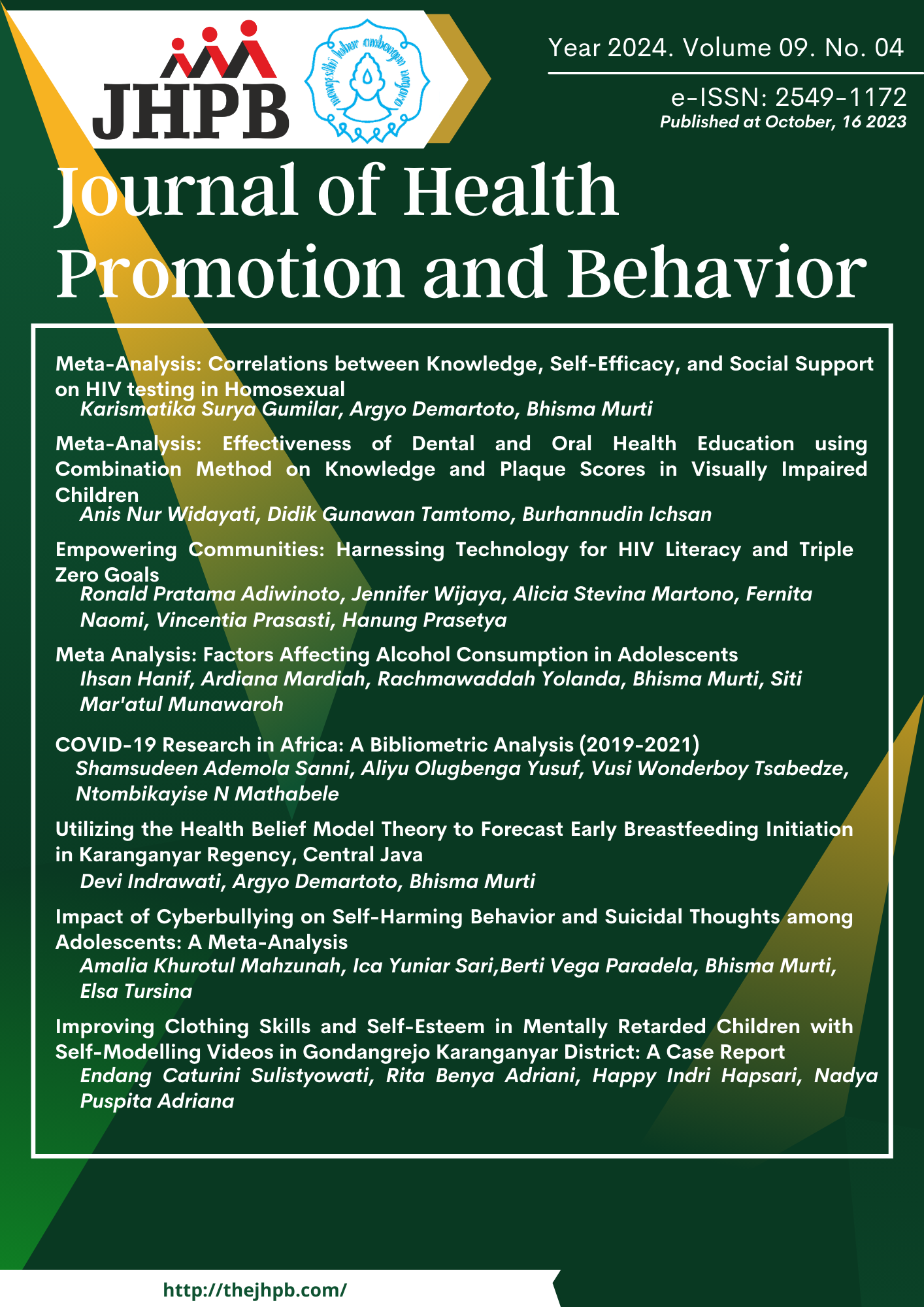The Impact of Cyberbullying on Self-Harming Behavior and Suicidal Thoughts among Adolescents: A Meta-Analysis
DOI:
https://doi.org/10.26911/thejhpb.2024.09.04.07Abstract
Background: Online bullying often occurs among teenagers. This is an important risk factor for self-injurious behavior and suicidal ideation. This study aimed to analyze and estimate the magnitude of the effect of online bullying on self-injurious behavior and suicidal ideation in adolescents.
Subjects and Method: This research is a systematic review and meta-analysis using the PICO model. Population: Adolescents, Intervention: Online bullying, Comparison: No online bullying, Outcome: Self-injurious behavior and suicidal ideation. The research data used was obtained through Google Scholar, Science Direct, BMC Public Health, and Scopus with the keywords (“Cyberbullying”) AND (“Self-harm”) AND (“Suicidal Ideation”) AND (“Mental Health”) AND (“Cross-sectional”). Inclusion criteria were cross-sectional articles in English published from 2014 to 2024. Data analysis was carried out using the Review Manager 5.3 application.
Results: Meta-analysis was conducted on 8 primary studies with outcomes for self-harm behavior and 9 primary studies with outcomes for suicidal ideation. These primary studies come from Singapore, Vietnam, Taiwan, China, South Korea, Iran, Australia and America. The sample size was 47,708 adolescents for self-injurious behavior outcomes and 63,173 adolescents for suicidal ideation outcomes. Adolescents with online bullying are 3.64 times more likely to have self-injurious behavior (aOR= 3.64; 95% CI= 3.14 to 4.22; p<0.001) and 2.64 times more likely to have suicidal ideation (aOR= 2.64; 95% CI= 1.94 to 3.60; p<0.001) compared to adolescents without online bullying. The funnel plot indicates the existence of publication bias which tends to reduce the true effect (underestimate) on the outcome of suicidal ideation.
Conclusion: Online bullying statistically significantly increases the risk of self-injurious behavior and suicidal ideation in adolescents.
Keywords:
cyberbullying, suicidal ideation, self-harm, adolescentsHow to Cite
References
Alhajji M, Bass S, Dai T (2019). Cyberbullying, mental health, and violence in adolescents and associations with sex and race: data from the 2015 youth risk behavior survey. Glob Pediatr Health. 6(1): 1-12. DOI: 10.1177/2333794X19868887.
Azami MS, Taremian F (2020). Victimization in traditional and cyber-bullying as risk factors for substance use, self-harm, and suicide attempts in high school students. SJCAPP. 8(1): 101–109. DOI: 10.21307/sjcapp-2020-010.
Bai Q, Huan S, Hsueh FH, Zhang T (2021). Cyberbullying victimization and suicide ideation: A crumbled belief in a just world. Comput Hum Behav. 120(1): 1–12. DOI: 10.1016/j.chb.2021.106679.
Beauroy-eustache OD, Mishara BL (2021). Systematic review of risk and protective factors for suicidal and self-harm behaviors among children and adolescents involved with cyberbullying. Prev Med. 152(1): 106-116. DOI: 10.1016/j.ypmed.2021.106684.
Calvete E, Orue I, Gámez-Guadix M (2016). Cyberbullying victimization and depression in adolescents: the mediating role of body image and cognitive schemas in a one-year prospective study. Eur J Crim Pol. 22(2): 271–284. DOI: 10.1007/s10610-015-9292-8.
Carvalho M, Branquinho C, de-Matos MG. (2021). Cyberbullying and bullying: impact on psychological symptoms and well-being. Child Indic Res. 14(1): 435–452. DOI: 10.1007/s12187-020-09756-2.
Elgar FJ, Napoletano A, Saul G, Dirks MA, Craig W, Paul PV, Holt M, et al. (2014). Cyberbullying victimization and mental health in adolescents and the moderating role of family dinners. JAMA Pediatrics. 168(11): 1015–1022. DOI: 10.1001/jamapediatrics.2014.12-23.
Extremera N, Quintana-Orts C, Mérida-López S, Rey L (2018). Cyberbullying victimization, self-esteem, and suicidal ideation in adolescence: does emotional intelligence play a buffering role?. Front Psychol. 9(367): 1–9. DOI: 10.3389/fpsyg.2018.00367.
Eyuboglu M, Eyuboglu D, Caliskan S, Oktar D, Demirtas Z (2021). Traditional school bullying and cyberbullying : Prevalence, the effect on mental health problems and self-harm behavior. Psychiatry Res. 297(1): 113-123. DOI: 10.1016/j.psychres.2021.113730.
Felipe-castaño E, León-del-barco B, Polo-del-río MI, Mendo-lázaro S, Gómez-carroza T, Fajardo-bullón F (2019). Differential analysis of psychopathological impact of cyberbullying in university students. Front Psychol. 10(6): 1–8. DOI: 10.3389/fpsyg.2019.01620.
Fitriah F, Murti B, Tamtomo DG. (2021). The Effect of bullying on depression in adolescents: a meta-analysis. JHPB. 6(2): 112-121. DOI: 10.26911/thejhpb.2021.06.02.04.
Hébert M, Cénat JM, Blais M, Lavoie F, Guerrier M (2016). Child sexual abuse, bullying, cyberbullying, and mental health problems among high schools students: a moderated mediated model. Depression and Anxiety. 33(7): 623–629. DOI: 10.1002/da.22504.
Islam MI, Khanam R, Kabir E (2020). Bullying victimization, mental disorders, suicidality and self-harm among Australian high school children: evidence from nationwide data. Psychiatry Res. 292(2): 113-123. DOI: 10.1016/j.psychres.2020.113364.
Islam MI, Yunus FM, Kabir E, Khanam R (2022). Evaluating risk and protective factors for suicidality and self-harm in Australian adolescents with traditional bullying and cyberbullying victimization. Am J of Health Promot. 36(1): 73–83. DOI: 10.1177/08901-171211034105.
Jin X, Zhang K, Twayigira M, Gao X, Xu H, Huang C, Luo X, et al. (2023). Cyberbullying among college students in a Chinese population: Prevalence and associated clinical correlates. Front Public Health. 11(1): 1-12. DOI: 10.-3389/fpubh.2023.1100069.
John A, Glendenning AC, Marchant A, Montgomery P, Stewart A, Wood S, Lloyd K, et al. (2018). Self-harm, suicidal behaviors, and cyberbullying in children and young people: a systematic review. JMIR. 20(4): 129-139. DOI: 10.2196/jmir.9044.
Kee DMH, Anwar A, Vranjes I (2024). Cyberbullying victimization and suicide ideation: The mediating role of psychological distress among Malaysian youth. Comput Hum Behav. 150(3): 108-118. DOI: 10.1016/j.chb.2023.108000.
Lan YT, Pan YC, Lin YH (2022). Association between adolescents’ problematic online behaviors and self-harm risk. J Affect Disord. 317(35): 46–51. DOI: 10.1016/j.jad.2022.08.073.
Lee J, Chun J, Kim J, Lee J, Lee S (2021). A social-ecological approach to understanding the relationship between cyberbullying victimization and suicidal ideation in South Korean adolescents: The moderating effect of school connectedness. Int J Environ Res Public Health. 18(20): 1-10. DOI: 10.3390/ijerph182010623.
Mallik CI (2020). Adolescent victims of cyberbullying in Bangladesh prevalence and relationship with psychiatric disorders. Asian J Psychiatr. 48(9): 101-110. DOI: 10.1016/j.ajp.-2019.101893.
Marengo N, Borraccino A, Charrier L, Berchialla P, Dalmasso P, Caputo M (2021). Cyberbullying and problematic social media use : an insight into the positive role of social support in adolescents d data from the Health Behaviour in School-aged Children study in Italy. Public Health. 199(1): 46–50. DOI: 10.1016/j.puhe.2021.08.010.
Maurya C, Muhammad T, Dhillon P, Maurya P (2022). The effects of cyberbullying victimization on depression and suicidal ideation among adolescents and young adults: a three year cohort study from India. BMC Psychiatry. 22(1): 599-610. DOI: 10.1186/s12888-022-04238-x.
Memon A, Sharma S, Mohite S, Jain S (2018). The role of online social networking on deliberate self-harm and suicidality in adolescents: A systematized review of literature. Indian J Psychiatry. 60(4): 384-390. DOI: 10.4103/psychiatry.IndianJ-Psychiatry_414_17.
Myklestad I, Straiton M (2021). The relationship between self-harm and bullying behavior: results from a population-based study of adolescents. BMC Public Health. 21(1): 524-530. DOI: 10.1186/s12889-021-10555-9.
Nguyen HTL, Nakamura K, Seino K, Vo VT (2020). Relationships among cyber-bullying, parental attitudes, self-harm and suicidal behavior among adolescents: Results from a school-based survey in Vietnam. BMC Public Health. 20(1): 1–10. DOI: 10.1186/-s12889-020-08500-3.
Nikolaou D (2017). Does cyberbullying impact youth suicidal behaviors? J Health Econ. 56(1): 30–46. DOI: 10.1016/j.jhealeco.2017.09.009
Nixon C (2014). Current perspectives: the impact of cyberbullying on adolescent health. Adolesc Health Med Ther. 1(1): 1-9. DOI: 10.2147/ahmt.s36456.
Ong SH, Tan YR, Khong JZN, Elliott JM, Sourander A, Yliopisto T, Fung DSS (2020). Association of cyberbullying with psychosocial difficulties, self-harm, and helping-seeking behaviors: a cross-sectional study in Singapore adolescents. Research Square. 1(1): 1–21. DOI: 10.21203/rs.2.20388/v1.
Peng Z, Klomek AB, Li L, Su X, Sillanmäki L, Chudal R, Sourander A (2019). Associations between Chinese adolescents subjected to traditional and cyberbullying and suicidal ideation, self-harm, and suicide attempts. BMC Psychiatry. 19(1): 1–8. DOI: 10.1186/s12888-019-2319-9.
Peprah P, Oduro MS, Okwei R, Adu C, Asiamah-Asare BY, Agyemang-Duah W (2023). Cyberbullying victimization and suicidal ideation among in-school adolescents in three countries: implications for prevention and intervention. BMC Psychiatry. 23(1): 944-934. DOI: 10.1186/s12888-023-05268-9.
Privetera H, Soemanto R, Prasetya H. (2020). Effect of bullying on the risk of anxiety and social interaction disorder among senior high school in Yogyakarta. JHPB. 5(4): 306–316. DOI: 10.26911/thejhpb.2020.05.04.-08.
Sudrajat K, Soemanto R, Prasetya H. (2020). The effect of bullying on depression, academic activity, and communication in adolescents in Surakarta: a multilevel logistic regression. JHPB. 5(2): 79–86. DOI: 10.26911/-thejhpb.2020.05.02.02.
Yang B, Wang B, Sun N, Xu F, Wang L, Chen J, Yu S, et al. (2021). The consequences of cyberbullying and traditional bullying victimization among adolescents: gender differences in psychological symptoms, self-harm, and suicidality. Psychiatry Res. 306(1): 1-8. DOI: 10.1016/j.psychres.-2021.114219.




